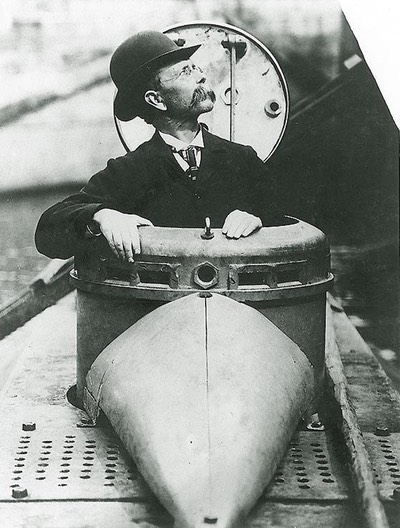Now and then on a slow news day in central Colorado, some TV station or local newspaper will send a reporter to the Gilpin County Museum to cover a singular bit of local history. Inside the museum lies the salvaged remnant of a small submarine which sank on its maiden voyage in 1898. To underscore just how unusual the story is, the reporter generally reminds his audience that Gilpin County is 9,000 feet above sea level and almost 1,000 miles from the nearest ocean. Yet, there it is, a mouldering wooden frame in the shape of slender football, with a hit-or-miss patchwork of small lead or zinc plates still clinging to the ribs. The hull of the submarine is almost 20 feet long, 5 feet tall at the center, and a bit more than 3 feet wide. It was designed to be propelled by a hand-crank, which never got the chance to demonstrate whether it was up to the job.
Building a turn-of-the-century submarine in the mountains was the idea of Central City contractor R. T. Owens, who convinced a group of local businessmen to finance the experiment.
John Philip Holland
The 19th-century inventor is pictured in the conning tower of a proper submarine, the Holland VI, in 1898.

Courtesy of the U.S. Naval Institute, Annapolis, Maryland, 1966. NHHC Photograph Collection, NH 63092.
1898 was a lively year in the evolution of submersible war machines. Five years earlier, the U.S. Navy had announced a competition for a winning design to provide the basis for their projected submarine fleet. The front-runner was inventor John Holland who in 1898 formed the Electric Boat Company, after offering to go to Cuba and sink every Spanish warship he could find. Secretary of the Navy Theodore Roosevelt was impressed with Holland’s latest submarine, even though it still needed some tinkering.
It seems doubtful that Owens believed his dinky one-man boat could snatch the Navy prize from Holland. But, submarines were much in the news that year, and Owens may have capitalized on the headlines to design his ship as a public relations gimmick for his contracting firm. The stunt did garner publicity, but none that would put his skills in a flattering light.
Two carpenters were hired to construct the ship from Owens’s plans, in a shed out back of the Eclipse Livery Stable. Owens dubbed his craft Nautilus, probably after the fictional Captain Nemo’s ship, although it was also the name of John Holland's submarine company that went bankrupt in 1883. When Owens decided his prototype was ready for a test dive, it was was hauled by wagon to Missouri Lake, two miles from Central City. While Owens always intended to pilot Nautilus himself, friends warned him to try its seaworthiness before stepping on board. With a few tons of rock ballast piled inside, the submarine was dropped into the water and promptly sank without a trace. That was where it remained for 46 years.
Owens quietly ducked out of town, and the memory of his submarine slipped away into legend, like the Loch Ness Monster or that giant catfish which is rumored to haunt the depths of Tuttle Creek Reservoir in northern Kansas. During World War II, with submarines once again making news, Fred De Mandel began searching for the lost ship that was rumored to lie on the bottom of Missouri Lake, finally spotting the nose of Nautilus as he peered into a hole that had been chiseled through 14 inches of ice on a cold January day in 1944. The hulk was hauled from the lake by a chain and brought back to Central City, which declared a holiday. School was let out and offices closed to allow citizens to line the streets and watch their local legend come back home.
Newspapers in 1944 looked for someone with a connection to the story to comment on it, and that’s how it came to my attention. The witness they found was Oscar Williams, longtime sheriff of Gilpin County, the man who donated the “Pikes Peak or Bust” photograph to the Denver Public Library, and the man I believe to be the grandson of the dude in the photograph who wears an oversized white hat and suspenders. Oscar Williams was also a witness to the brief, ill-fated and only voyage of Nautilus.
I was a young fellow and probably inclined as much as any to scoff a little at the idea. We got out our biggest flat-bed wagon - the biggest in town - and a crew of men hoisted the boat onto it. The boat was a size or two too big for the wagon.
We hauled it up the canyon … quite a crowd followed us up the mountain. I guess they got too much ballast in her. She sank with a splash and never came up.
R. T. Owens and his Nautilus is one of those odd items that turned up while I was researching the men who gathered to have their picture taken in Riley’s Gulch near Denver in late 1859 or early 1860. It’s a story of no real consequence, just a harebrained notion that struck a few people in Central City as worth pursuing. Perhaps R. T. Owens was a Jules Verne fan who had always dreamed of commanding his own submarine. Landing in Central City, where there was mining money, more than anyone knew what to do with, someone bankrolled his dream. He was Captain Nemo for a while, until the boat sank.